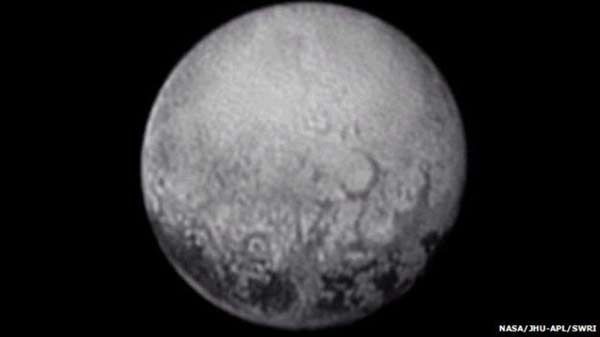California, US (BBN)-Take a good look at the latest picture of Pluto because it shows the face of the dwarf planet that will not be seen during next week’s historic flyby.
The US space agency’s New Horizons probe was less than 2.5 million km from the diminutive world on Saturday and closing in fast, reports BBC.
Come Tuesday, it will be grabbing shots from an altitude of just 12,500km.
But the newly published image, showing Pluto’s “spots”, is of the hemisphere that will soon rotate out of view.
It will not be seen again until after New Horizons has gone behind the 2,300km-wide dwarf, and then only in the faint light reflected off the little planet’s biggest moon, Charon.
That in itself should make for some fascinating science, however, because it will tell researchers what happens on Pluto’s dark side.
Some models predict that its nitrogen-rich atmosphere snows out in the deep cold of night.
The mission team will be able to determine if this is so by studying changes in the patterns of reflectivity.
Pluto’s four dark spots first came into focus at the end of June.
The intrigue is their regular spacing and size, with each being about 480km across.
Alan Stern, the principal investigator on New Horizons, spoke to the BBC on Saturday to convey the mood inside his team ahead of the flyby.
“It’s electric; it’s truly electric,” the Southwest Research Institute professor said.
“People are just thrilled and they have big smiles on their faces, and the data that’s coming down – even though it’s only a small amount of what the spacecraft’s taking – is so beautiful.
“Pluto is not disappointing. Pluto is spectacular.”
New Horizons is travelling at almost 14km/s towards its target.
At that speed it cannot go into orbit, and must simply barrel past, acquiring as many images and other types of data as it can.
The hemisphere it will characterise in most detail is centred on a region between a very dark equatorial band that has come to be known as “the whale” and a remarkably bright expanse of terrain shaped like a heart.
New Horizons’ long-range camera, Lorri, will carpet map two 80km-wide strips across this hemisphere, revealing surface features down to a best resolution of 80m per pixel.
All of the probe’s information will come back very slowly, however.
The vast distance to Pluto – some 4.7bn km – means bit rates are extremely slow, and it will take a full 16 months for everything seen in the next few days to trickle back to Earth.
Closest approach to Pluto on Tuesday is set for exactly 11:49:59 GMT (12:49:59 BST; 07:49:59 EDT).
A successful rendezvous will complete the reconnaissance of the “classical nine planets”, with every one then having been visited by a probe at least once.
The last major world to get this treatment was Neptune, which was passed by Voyager-2 in 1989 on its way out into deep space.
BBN/SK/AD

No Subscription? You Are Missing Out!
Join the business leaders of Bangladesh who rely on BBN's original reporting and in-depth analysis on business scenario of the country. We send only one daily email. No Spam Guaranteed!









